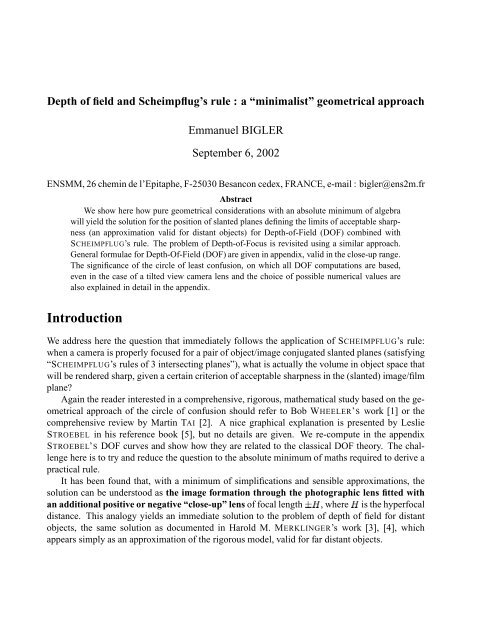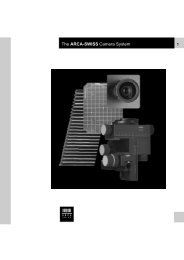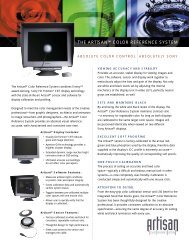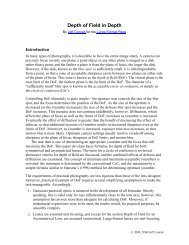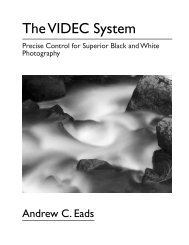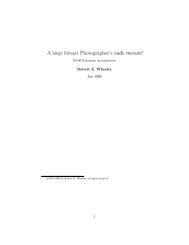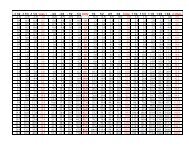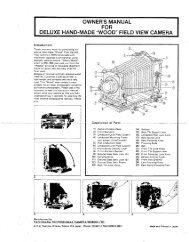Depth of field and Scheimpflug's rule - Large Format Photography. Info
Depth of field and Scheimpflug's rule - Large Format Photography. Info
Depth of field and Scheimpflug's rule - Large Format Photography. Info
Create successful ePaper yourself
Turn your PDF publications into a flip-book with our unique Google optimized e-Paper software.
<strong>Depth</strong> <strong>of</strong> <strong>field</strong> <strong>and</strong> Scheimpflug’s <strong>rule</strong> : a “minimalist” geometrical approach<br />
Emmanuel BIGLER<br />
September 6, 2002<br />
ENSMM, 26 chemin de l’Epitaphe, F-25030 Besancon cedex, FRANCE, e-mail : bigler@ens2m.fr<br />
Abstract<br />
We show here how pure geometrical considerations with an absolute minimum <strong>of</strong> algebra<br />
will yield the solution for the position <strong>of</strong> slanted planes defining the limits <strong>of</strong> acceptable sharpness<br />
(an approximation valid for distant objects) for <strong>Depth</strong>-<strong>of</strong>-Field (DOF) combined with<br />
SCHEIMPFLUG’s <strong>rule</strong>. The problem <strong>of</strong> <strong>Depth</strong>-<strong>of</strong>-Focus is revisited using a similar approach.<br />
General formulae for <strong>Depth</strong>-Of-Field (DOF) are given in appendix, valid in the close-up range.<br />
The significance <strong>of</strong> the circle <strong>of</strong> least confusion, on which all DOF computations are based,<br />
even in the case <strong>of</strong> a tilted view camera lens <strong>and</strong> the choice <strong>of</strong> possible numerical values are<br />
also explained in detail in the appendix.<br />
Introduction<br />
We address here the question that immediately follows the application <strong>of</strong> SCHEIMPFLUG’s <strong>rule</strong>:<br />
when a camera is properly focused for a pair <strong>of</strong> object/image conjugated slanted planes (satisfying<br />
“SCHEIMPFLUG’s <strong>rule</strong>s <strong>of</strong> 3 intersecting planes”), what is actually the volume in object space that<br />
will be rendered sharp, given a certain criterion <strong>of</strong> acceptable sharpness in the (slanted) image/film<br />
plane?<br />
Again the reader interested in a comprehensive, rigorous, mathematical study based on the geometrical<br />
approach <strong>of</strong> the circle <strong>of</strong> confusion should refer to Bob WHEELER’S work [1] or the<br />
comprehensive review by Martin TAI [2]. A nice graphical explanation is presented by Leslie<br />
STROEBEL in his reference book [5], but no details are given. We re-compute in the appendix<br />
STROEBEL’S DOF curves <strong>and</strong> show how they are related to the classical DOF theory. The challenge<br />
here is to try <strong>and</strong> reduce the question to the absolute minimum <strong>of</strong> maths required to derive a<br />
practical <strong>rule</strong>.<br />
It has been found that, with a minimum <strong>of</strong> simplifications <strong>and</strong> sensible approximations, the<br />
solution can be understood as the image formation through the photographic lens fitted with<br />
an additional positive or negative “close-up” lens <strong>of</strong> focal length ¢¡ , where ¡ is the hyperfocal<br />
distance. This analogy yields an immediate solution to the problem <strong>of</strong> depth <strong>of</strong> <strong>field</strong> for distant<br />
objects, the same solution as documented in Harold M. MERKLINGER’s work [3], [4], which<br />
appears simply as an approximation <strong>of</strong> the rigorous model, valid for far distant objects.
1 Derivation <strong>of</strong> the position <strong>of</strong> slanted limit planes <strong>of</strong> acceptable<br />
sharpness<br />
1.1 Starting with reasonable approximations<br />
Consider a situation where we are dealing with a pair <strong>of</strong> corresponding slanted object <strong>and</strong> image<br />
planes according to SCHEIMPFLUG’s <strong>rule</strong> (fig. 4), <strong>and</strong> let us first assume a few reasonable<br />
approximations:<br />
1. first we neglect the fact that the projection <strong>of</strong> a circular lens aperture on film, for a single, out<br />
<strong>of</strong> focus point object, will actually be an ellipse <strong>and</strong> not a circle. This is well explained by<br />
Bob WHEELER [1] who shows, after a complete rigorous calculation, that this approximation<br />
is very reasonable in most practical conditions.<br />
2. second we consider only far distant objects; in other words we are interested to know the<br />
position <strong>of</strong> limit surfaces <strong>of</strong> sharpness far from the camera, i.e. distances or ¡ much greater<br />
than the focal length ¢ . We’ll show that those surfaces in the limit case are actually planes,<br />
the more rigorous shape <strong>of</strong> these surfaces for all object-to-camera distances can be found in<br />
Bob WHEELER’s paper, in Leslie STROEBEL’s book [5], <strong>and</strong> here in the appendix.<br />
3. finally we’ll represent the lens as a single positive lens element; in other words we neglect<br />
the distance between the principal planes <strong>of</strong> the lens, which will not significantly change the<br />
results for far distant objects, provided that we consider a quasi-symmetrical camera lens<br />
(with the notable exception <strong>of</strong> telephoto lenses, this is how most view camera lenses are<br />
designed).<br />
1.2 A “hidden treasury” in classical depth-<strong>of</strong>-<strong>field</strong> formulae !<br />
Let us restart, as a minimum <strong>of</strong> required algebra, with the well-know expressions for classical depth<br />
<strong>of</strong> <strong>field</strong> distances, in fact the ones used in practice <strong>and</strong> mentioned in numerous books, formulae on<br />
which are based the DOF engravings on classical manually focused lenses.<br />
Consider an £¥¤ object perpendicular to the optical axis, ¡§¦ let ¡©¨ <strong>and</strong> the positions (measured<br />
from the lens plane in ) <strong>of</strong> the planes <strong>of</strong> acceptable sharpness around a given position <strong>of</strong> the<br />
¡ object .<br />
It should be noted (see fig. 1) that the ray tracing for a couple <strong>of</strong> points outside the optical<br />
axis ¦ like ¦ <strong>and</strong> yields in the image £¤ plane an out-<strong>of</strong>-focus image <strong>of</strong> circular shape (not<br />
an ellipse, as it could be considered at a first); this out-<strong>of</strong>-focus image is exactly the same as the<br />
circular spot originated ¦ from ; this is simply the classical property <strong>of</strong> the conical projection <strong>of</strong><br />
a circular aperture between two parallel planes. The out-<strong>of</strong>-focus spot near is centred on the<br />
median ¦ ¦ ray that crosses the lens at its optical centre. This point will be important in<br />
the discussion about transversal magnification factors for out-<strong>of</strong>-focus images.<br />
2
Figure 1: <strong>Depth</strong>-<strong>of</strong>-<strong>field</strong> distances ¦ , ¡ ¦ <strong>and</strong> ¨ , ¡©¨ for a given circle <strong>of</strong> confusion ¡<br />
¢<br />
¤<br />
¢<br />
£<br />
¢<br />
£<br />
¢<br />
¡<br />
¤<br />
¢<br />
¤<br />
¡<br />
¢<br />
¤<br />
¢<br />
£<br />
¢<br />
¢<br />
¢<br />
£<br />
¤<br />
¢<br />
¡<br />
¢<br />
¢<br />
¨<br />
¦<br />
£<br />
¢<br />
¦<br />
far plane<br />
<strong>of</strong> acceptable<br />
sharpness<br />
P2<br />
object<br />
plane<br />
s2<br />
D<br />
B<br />
A<br />
D1<br />
p2<br />
near plane<br />
<strong>of</strong> acceptable<br />
sharpness<br />
P1<br />
s<br />
s1<br />
p<br />
F<br />
f<br />
p1<br />
lens plane<br />
I<br />
O<br />
p’<br />
f<br />
F’<br />
focal<br />
plane<br />
s’<br />
D’ D’1<br />
A’<br />
B’<br />
film<br />
plane<br />
circle <strong>of</strong><br />
confusion<br />
c<br />
Assuming a given value for , the diameter <strong>of</strong> the circle <strong>of</strong> confusion, ¡ ¦ <strong>and</strong> ¡©¨ are identical<br />
whether we consider ¡ on-axis or <strong>of</strong>f-axis <strong>and</strong> is given, for far distant objects, by<br />
££<br />
¢<br />
¥ ¡<br />
¢<br />
(1)<br />
¡<br />
In eq.(1), ¡ is the hyperfocal distance for a given numerical aperture § <strong>and</strong> diameter <strong>of</strong> the<br />
circle <strong>of</strong> confusion ¡ , defined as usual as<br />
¡ ¦<br />
¡©¨<br />
£ ¢©¨ ¢<br />
¡<br />
¡ §¨<br />
The previous expressions <strong>of</strong> eq. (1) are valid only for far-distant objects; readers interested by<br />
more exact expressions, valid also for close-up situations, will find them below in the appendix.<br />
Now let us combine eq.(1) with the well-known object-image equation (known in France as<br />
DESCARTES formulae), written here with positive values ¡ <strong>of</strong> ¡ <strong>and</strong> (the photographic case)<br />
£ ¢<br />
§ ¡ (2)<br />
(3)<br />
Combining equation (1) into (3) yields the interesting formula (4)<br />
¡ <br />
¢<br />
¥ ¡<br />
¢<br />
(4)<br />
¡<br />
¢<br />
¢<br />
¡ ¦<br />
¡ <br />
¡©¨<br />
¡ <br />
3
¢<br />
¢<br />
¤<br />
¦<br />
¢<br />
¢<br />
¦<br />
¢<br />
¢<br />
¤<br />
which is nothing but the object-image equation for the image £ located at a distance ¡ <strong>of</strong><br />
the lens centre , but as seen through an optical system <strong>of</strong> inverse focal length<br />
¢<br />
¢<br />
for ¡<br />
the near plane ¡ ¦ (point ¦ ) <strong>and</strong><br />
¢<br />
for the distant plane ¡ ¨ (point ¨ ). The expression<br />
¡<br />
¢<br />
¢<br />
¢<br />
¡<br />
is simply the inverse<br />
<strong>of</strong> the focal length <strong>of</strong> a compound system made <strong>of</strong> the<br />
¦ ¢<br />
original lens, fitted with a positive close-up lens <strong>of</strong> focal length .<br />
When you “glue” two thin single lens elements together into a thin compound with no air space,<br />
¡<br />
their convergences (inverse <strong>of</strong> the focal length) should simply be added. Thus in a symmetric way<br />
¢<br />
¢<br />
¡<br />
is nothing but the inverse<br />
¨ ¢<br />
original lens, fitted with a negative “close-up” lens <strong>of</strong> focal ¦<br />
¡<br />
length<br />
<strong>of</strong> the focal length <strong>of</strong> a compound system made <strong>of</strong> the<br />
.<br />
1.3 A positive or negative “close-up” lens to visualise DOF at full aperture?<br />
1.3.1 a classical DOF <strong>rule</strong> revisited<br />
Before we proceed to the SCHEIMPFLUG case, let us examine the practical consequence <strong>of</strong> the<br />
additional close-up lens approach in the simple case <strong>of</strong> parallel object <strong>and</strong> image planes. We’ll<br />
show how this additional lens element will allow us to revisit some well-know DOF <strong>rule</strong>s (figure 2).<br />
It is known to photographers that when a lens is focused on the hyperfocal distance , all<br />
objects ¡<br />
located between <strong>and</strong> infinity will be rendered approximately sharp on film, i.e. sharp<br />
within the DOF tolerance. Consider a lens focused on the hyperfocal distance <strong>and</strong> let us add ¡ £¢<br />
a<br />
¡<br />
positive close-up lens element <strong>of</strong> focal length . The ray tracing on figure 2 shows that the<br />
object plane located at a distance is now imaged sharp on film if the lens to film distance<br />
is unchanged. In a symmetric way, the same photographic lens fitted with a negative “close-up”<br />
¤<br />
¡ ¤¢<br />
additional lens element ¦<br />
¡<br />
<strong>of</strong> focal length will focus a sharp image on film for objects located at<br />
infinity. The same considerations actually apply whatever the object to lens distance might be, in<br />
this case formulae (4) are simply a more general <strong>rule</strong> valid for any object ¡ to lens distance ; the<br />
result is eventually the same, i.e. the positions ¡ ¦ <strong>of</strong> ¡©¨ acceptable sharpness <strong>and</strong> are located where<br />
the film “would see sharp” through the camera lens fitted with a positive or a negative “close-up”<br />
¡<br />
lens <strong>of</strong> focal ¦<br />
¡<br />
length or .<br />
¤<br />
1.3.2 DOF visualisation at full aperture??<br />
¤ ¡<br />
¦<br />
¡<br />
It would be nice to be able to use this trick in practice to check for depth <strong>of</strong> <strong>field</strong> without stopping<br />
the lens down to a small aperture. In large format photography, f/16 to f/64 are common, <strong>and</strong> the<br />
brightness <strong>of</strong> the image is poor; it is difficult to evaluate DOF visually in these conditions. The<br />
close-up lens trick would, in theory, allow to visualise the positions <strong>of</strong> limit planes <strong>of</strong> acceptable<br />
sharpness at full aperture simply by swapping a or supplementary lens by h<strong>and</strong> in front<br />
<strong>of</strong> the camera lens with the f-stop kept wide open.<br />
4
plane <strong>of</strong> sharpness<br />
now located at H/2<br />
lens<br />
plane<br />
f<br />
initial object plane<br />
located at the<br />
hyperfocal distance H<br />
A<br />
a positive close−up lens<br />
<strong>of</strong> focal length +H<br />
is added<br />
H/2<br />
O<br />
p’<br />
F’<br />
focal<br />
plane<br />
A’<br />
H<br />
with a close−up lens<br />
<strong>of</strong> positive power, +H,<br />
a film placed in A’<br />
"sees" sharp at a distance H/2<br />
sharpness plane<br />
located at infinity<br />
lens<br />
plane<br />
I<br />
f<br />
initial object plane<br />
located at the<br />
hyperfocal distance H<br />
A<br />
a negative "close−up" lens<br />
<strong>of</strong> focal length −H<br />
is added<br />
O<br />
p’<br />
F’<br />
focal<br />
plane<br />
A’<br />
H<br />
with a "close−up" lens<br />
<strong>of</strong> negative power −H,<br />
a film placed in A’<br />
"sees" sharp at infinity<br />
Figure 2: When the an additional “close-up” lens <strong>of</strong> positive or negative power +H or -H allows us<br />
to find well-know DOF <strong>rule</strong>s<br />
5
¨<br />
There is no reason why this could not work from an optical point <strong>of</strong> view. Unfortunately<br />
classical close-up lenses are always positive <strong>and</strong>, to the best <strong>of</strong> my knowledge, my favourite opticist<br />
round the corner will not have in stock eyeglasses with a focal length longer than 2 metres (a power<br />
smaller than 0.5 dioptre). The shop will probably have all kinds <strong>of</strong> positive <strong>and</strong> negative lenses in<br />
stock, but none, even on special order, will exhibit, say, a focal length <strong>of</strong> 10 metres (1/10 dioptre)<br />
because this is quite useless for correcting eyesight.<br />
In large format photography, the hyperfocal distance is always greater than 2 metres. For example<br />
a large format lens, with a focal length <strong>of</strong> 150 mm, for which we consider appropriate a circle<br />
<strong>of</strong> confusion <strong>of</strong> 100 microns has an hyperfocal distance smaller that 2 metres only when closed<br />
down at a f-stop smaller than f/112. An impossible aperture, <strong>and</strong> moreover for such “pinhole” kind<br />
<strong>of</strong> values, diffraction effects make the classical DOF model questionable.<br />
Let us however see if this could work in 35mm photography. Shift <strong>and</strong> tilt lenses do exist for<br />
35mm SLR cameras. Consider a moderate wide-angle <strong>of</strong> 35 mm focal length <strong>and</strong> assume that<br />
the circle <strong>of</strong> confusion is chosen equal to the conventional <strong>and</strong> widely used value <strong>of</strong> 33 microns.<br />
The hyperfocal distance is equal to 2 metres at f/18: this is a more realistic value. Those who use<br />
shift <strong>and</strong> tilt lenses, 35mm focal length on a 35mm SLR can actually use a +0.5 or -0.5 dioptre<br />
supplementary lens to get an idea <strong>of</strong> the DOF planes at f/16-f/22 without actually stopping down<br />
the lens. And we’ll show below that this will be useful also for moderate tilt angles.<br />
For large format photographers, actually the majority <strong>of</strong> users <strong>of</strong> tilts <strong>and</strong> shifts, the trick <strong>of</strong><br />
a positive or negative “close-up” lens will only be a very simple geometrical help to determine<br />
where the slanted planes <strong>of</strong> acceptable sharpness in object space are located, as explained now.<br />
1.4 Where Mr. Scheimpflug helps us again <strong>and</strong> gives the solution<br />
When the film plane is tilted, the ray tracing is similar to the one on figs.1 <strong>and</strong> 2, but the object<br />
plane is slanted (figures 3 <strong>and</strong> 4). We show now that even in this case, we can also consider<br />
the camera lens fitted with a positive or negative close-up lens to determine the object planes <strong>of</strong><br />
acceptable sharpness.<br />
1.4.1 a last argumentation without analytical calculations...<br />
Now a subtle question that arises is: we now have the formula connecting the longitudinal position<br />
<strong>of</strong> out-<strong>of</strong>-focus pseudo-images (actually: elliptical patches, close to a circle, when the tilt angle<br />
is small) in the slanted film plane with the corresponding longitudinal position <strong>of</strong> a point source<br />
in the object space. But what is the transversal magnification factor? To find this we need an<br />
additional diagram (figure 3).<br />
Due to basic properties <strong>of</strong> a geometrical projection <strong>of</strong> centre , if we neglect the “ellipticity”<br />
<strong>of</strong> the DOF spot, the centre <strong>of</strong> the out-<strong>of</strong>-focus £ ¨ image, , is aligned with the median £¥¨ £ ¨ ray .<br />
Hence, the transversal magnification factor for an out-<strong>of</strong>-focus £ image is the same as a for<br />
a true image £ ¨ when is formed “sharp” through a compound lens fabricated by adding a thin<br />
6
p2<br />
p<br />
p’<br />
lens<br />
plane<br />
object plane<br />
slanted film plane<br />
farDOF limit<br />
O A2’ A2" spot size<br />
A2<br />
**if the ellipse effect is neglected**<br />
(small tilt angle)<br />
the centre <strong>of</strong> the projected spot A2"<br />
is aligned with A2 O A2’<br />
Figure 3: The transversal magnification factor for an out-<strong>of</strong>-focus pseudo-image, ¡ ¡©¨ , is the same<br />
as for a true image through a compound lens<br />
supplementary lens to the camera lens. This transversal magnification factor (see fig. 3) is equal to<br />
¡ ¨ , the same value would be obtained for £ ¨ as a true image through the compound lens.<br />
¡<br />
So both in longitudinal <strong>and</strong> transversal position the correspondence between the object space<br />
<strong>and</strong> the image space for out-<strong>of</strong>-focus images is exactly the same as if viewed “sharp” through the<br />
compound lens. Applying basic <strong>rule</strong>s <strong>of</strong> true object-image formation we already know that the<br />
image <strong>of</strong> a slanted plane is another slanted plane, we do not need any analytical pro<strong>of</strong> to derive<br />
what follows.<br />
1.4.2 ...<strong>and</strong> Mr. Scheimpflug gives us the solution without any calculation!!<br />
¢ ¦ ¡ ¦ ¢ ¨ ¡©¨<br />
¦ ¦ ¨ ¨ ¡ £¢¡<br />
¡ £¥<br />
¡ ¦ ¦ ¡©¨ ¨<br />
¨ £¥¤¨ ¨ £¡ ¤ ¦ £¥ ¦ ¡ ¦<br />
¤<br />
£<br />
£¡ ¤§¦<br />
¤©¨<br />
As a consequence, without any further calculations we apply SCHEIMPFLUG’s <strong>rule</strong> to the compound<br />
optical system <strong>and</strong> we conclude that the limit surfaces <strong>of</strong> acceptable sharpness for distant<br />
objects are the slanted conjugate planes <strong>of</strong> the film plane with respect to a compound,<br />
thin lens centred in , with a focal length equal to (for ) or (for ), <strong>and</strong> that all<br />
those planes <strong>and</strong> intersect together in with the slanted object plane <strong>and</strong> the<br />
slanted SCHEIMPFLUG-conjugated image plane as on fig.4.<br />
To actually define where those planes are located, we simply have to impose that they should<br />
cut the optical axis at a distance (point ) or (point ), respectively. Then, simple geometric<br />
considerations on homothetic triangles vs. as well as vs. combined<br />
with eq.1 yield the interesting <strong>and</strong> most simple final result: with , both distances <strong>and</strong><br />
are equal to<br />
¤©¨ £<br />
¤ ¦ £<br />
¤<br />
¡<br />
(5)<br />
¡<br />
Now consider a plane ¦¥ ¦ ¨ perpendicular to the optical axis <strong>and</strong> located at the hyperfocal<br />
7
G 1<br />
h<br />
hyperfocal distance<br />
H<br />
G<br />
h<br />
p<br />
G 2 B 1<br />
h f<br />
P 1<br />
2 P<br />
A 1<br />
F O F’<br />
h C 2<br />
C’<br />
A’<br />
B 2<br />
approx<br />
not valid<br />
here<br />
h<br />
p 2<br />
p 1<br />
S<br />
Figure 4: Position <strong>of</strong> slanted planes <strong>of</strong> acceptable sharpness, for distant objects, according to this<br />
simplest model: fit the original lens with “close-up” lenses <strong>of</strong> focal length ( ¢¡<br />
8
¢<br />
¤<br />
<br />
¢<br />
¢<br />
¥<br />
¢<br />
¤<br />
¢<br />
<br />
¢<br />
¡<br />
¡ £ © ¢<br />
<br />
¤<br />
vs. , we eventually get<br />
¦ ¦ £<br />
¦ ¨ £<br />
¤ (6)<br />
a nice result given by Harold M. MERKLINGER in ref.[4]. Note that for far distant objects,<br />
the image point £ on the optical axis is located very close to the image focal point ; thus the<br />
distance ¤ , hard to estimate in practice, can be computed from the “camera triangle” ¡ £ from<br />
the focal length ¢<br />
¢£¦¥¨§<br />
£ © ¥§<br />
<strong>and</strong> the estimated tilt angle<br />
¡<br />
¡ £ as: ¢¤£¦¥¨§<br />
<br />
. For small tilt angles<br />
¡ ¡<br />
£¡ £ , which eventually yields the same result as in reference [4], where the<br />
£¡<br />
diagram is drawn with a reference line perpendicular to the film plane (hence a instead <strong>of</strong> a<br />
<br />
) instead <strong>of</strong> the lens plane like here.<br />
2 Application to the problem <strong>of</strong> <strong>Depth</strong>-<strong>of</strong>-Focus<br />
Another classical photographic problem is the determination <strong>of</strong> <strong>Depth</strong>-<strong>of</strong>-Focus. The question is:<br />
for a given, fixed, object plane, what is the mechanical tolerance on film position in order to get a<br />
good image, within certain acceptable tolerances? The following (figure 5) yields the solution, at<br />
least to start with the case <strong>of</strong> an object plane perpendicular to the optical axis <strong>and</strong> an image plane<br />
parallel to the object plane.<br />
If ¡ denotes the film position for an ideally sharp image <strong>of</strong> an object plane at a distance ¡ , the<br />
two acceptable limit film plane positions ¡ ¦ <strong>and</strong> ¡ ¨ are given by<br />
¤ ¢ ¢<br />
¥ ¡ ¨<br />
£ ¡ <br />
¡<br />
¦ ¢ ¢<br />
(7)<br />
¡<br />
¦<br />
£ ¡ ¡<br />
In order to keep the derivation as simple as possible <strong>and</strong> keep the equivalence with a true<br />
optical image formation valid, we need an additional but reasonable approximation, namely that<br />
the hyperfocal distance is much greater that the focal length ¢ . This is what happens in most<br />
cases <strong>and</strong> is argumented in the appendix. Within this approximation, it is found (see details in the<br />
¡<br />
appendix), not so surprisingly, that the limit ¡§¦ positions ¡©¨ <strong>and</strong> as defined above for the <strong>Depth</strong>-<strong>of</strong>-<br />
Field problem are approximately the optical conjugates <strong>of</strong> the ¡ ¦ positions ¡ ¨ <strong>and</strong> <strong>of</strong> the <strong>Depth</strong>-<strong>of</strong>-<br />
Focus problem through the photographic lens <strong>of</strong> focal ¢ length , as given by DESCARTES formula<br />
©<br />
¢<br />
©<br />
¢<br />
(8)<br />
Combining this eq.(8) with the transversal magnification formula ¡ ¦ ¡ or ¡ ¨ ¡ , still the same<br />
for pseudo-images (the centre <strong>of</strong> out-<strong>of</strong>-focus light spots) as for real images, we find that in the<br />
general case <strong>of</strong> a slanted object plane, for far distant objects (so that equation (1) is valid), the<br />
limit positions for the image planes in the <strong>Depth</strong>-<strong>of</strong>-Focus problem are given by two slanted<br />
¡ ¦<br />
¡ ¦<br />
¡©¨<br />
¡ ¨<br />
9
¨<br />
B<br />
lens<br />
plane<br />
focal<br />
plane<br />
image<br />
plane<br />
p’<br />
object<br />
plane<br />
A<br />
F<br />
f<br />
I f p’2<br />
O<br />
F’<br />
A2’’<br />
A’<br />
p’1<br />
c<br />
circle <strong>of</strong><br />
confusion<br />
p<br />
B’<br />
Figure 5: A ray tracing similar to the ones used in the <strong>Depth</strong>-<strong>of</strong>-Field problem yields the solution<br />
<strong>of</strong> the <strong>Depth</strong>-<strong>of</strong>-Focus problem<br />
planes, those slanted image planes <strong>of</strong> acceptable sharpness being the optical conjugates (through<br />
the lens <strong>of</strong> focal length f) <strong>of</strong> the slanted object planes in the <strong>Depth</strong>-<strong>of</strong>-Field problem.<br />
Hence, applying SCHEIMPFLUG’S <strong>rule</strong>, we conclude again that those slanted planes intersect<br />
together at the same point S (see fig. 6)<br />
Appendix : depth <strong>of</strong> <strong>field</strong> formulae also valid for close-up, reasonable<br />
limits for the choice <strong>of</strong> the circle <strong>of</strong> confusion<br />
<strong>Depth</strong>-<strong>of</strong>-Field formulae valid for close-up<br />
it is not too difficult (although rather<br />
perpendicular to the optical axis to derive more general formulae giving<br />
From NEWTON’s object-image formulae ¨ £ ¢ ¨ ¢ £ ¢<br />
lengthy) for an object £¤<br />
the position ¡ ¦ <strong>and</strong> ¡©¨ <strong>of</strong> the planes <strong>of</strong> acceptable sharpness around a given position <strong>of</strong> the object ¡<br />
(as measured from the lens plane, see fig.1).<br />
Those exact formulae (9) <strong>and</strong> (10) are used in a html-javascript [7] <strong>and</strong> a downloadable spreadsheet<br />
[8] on Henri Peyre’s French web site. Another derivation, strictly equivalent, is proposed by<br />
Nicholas V. Sushkin [6] <strong>of</strong>fering an in-line graph.<br />
There is however a restriction: those formulae will be also valid for a thick compound lens<br />
where the pupil planes are located not too far from the nodal planes identical to principal planes<br />
10
slanted object plane<br />
P2 A P1<br />
C<br />
p 2<br />
p 1<br />
limit image plane P’2, <strong>Depth</strong>−<strong>of</strong>−Focus<br />
slanted image plane<br />
limit image plane P’1, <strong>Depth</strong>−<strong>of</strong>−Focus<br />
S<br />
P1 <strong>and</strong> P’1 are optically conjugated through the camera lens <strong>of</strong> focal length f<br />
same for P2 <strong>and</strong> P’2, when H >> f, <strong>and</strong> p >> f<br />
Figure 6: For a slanted object £¡ plane located far from the lens, <strong>and</strong> when the hyperfocal distance<br />
is much greater than the focal length, the image planes <strong>of</strong> acceptable ¡ ¦ sharpness ¡ ¨ <strong>and</strong> in<br />
the <strong>Depth</strong>-<strong>of</strong>-Focus problem are the optical conjugates <strong>of</strong> the slanted <strong>Depth</strong>-<strong>of</strong>-Field object planes<br />
¦ <strong>and</strong> ¡ ¨ through the camera lens<br />
¡<br />
F<br />
O<br />
A’<br />
C’<br />
11
¢<br />
£<br />
¡<br />
¢<br />
¤<br />
¡<br />
¢<br />
<br />
¦ ¢ ¢<br />
¡<br />
¡ ¤<br />
§ ¡ ¦ ¢<br />
¢<br />
£<br />
¡<br />
¢<br />
¦<br />
¡<br />
¦ § ¡ ¦ ¢<br />
¡<br />
¢<br />
<br />
¦ ¢ ¢<br />
¡<br />
¢<br />
in air. This is the case obviously for a single lens element or a cemented doublet, but also for quasisymmetric<br />
view camera lenses; however for asymmetric lenses or more generally speaking for a<br />
lens where pupil planes are far from nodal planes, an extreme case being, for example, so-called<br />
telecentric lenses, this classical depth-<strong>of</strong>-<strong>field</strong> approach is no longer valid. Another ray tracing<br />
diagram has to be taken into account; <strong>of</strong> course depth-<strong>of</strong>-<strong>field</strong> will increase when stopping down<br />
such a lens, but this will not be quantitatively described by equations (9) or (10).<br />
Assuming a given value for ¡ , the diameter <strong>of</strong> the circle <strong>of</strong> confusion, a derivation not shown<br />
here yields the following (<strong>and</strong> surprisingly simple) result, which is presented in a slightly different<br />
but strictly equivalent form by Nicholas V. Sushkin on his web site [6]<br />
(9)<br />
these formulae can be also written as<br />
¡ ¦<br />
¥<br />
¡©¨<br />
¡<br />
¡<br />
¡¢<br />
¡<br />
(10)<br />
where (see ¢ fig.1) is the focal length <strong>of</strong> the lens (here considered as a single, positive, thin lens<br />
¡ element) the position (measured from the lens plane ) <strong>of</strong> the object £¥¤ plane , assumed to be<br />
perpendicular to the optical axis.<br />
¡ ¦ Then is the position <strong>of</strong> the near limit plane <strong>of</strong> sharpness ¡ ¨ <strong>and</strong> the position <strong>of</strong> the far limit<br />
plane <strong>of</strong> sharpness. It should be noted in eqs.(9), that all ¡ distances ¡ ¦ , , ¡©¨ <strong>and</strong> are (positive)<br />
distances measured with respect to the lens plane plane . Here, for a thin positive lens, is<br />
identical to the principal planes. No problem with a thick compound lens if pupillar planes are<br />
not too far from principal planes, re-starting from the single thin lens element you just have to<br />
“separate” “virtually” the object side from the image side by a distance equal to the (positive <strong>of</strong><br />
negative) spacing between principal planes.<br />
¡ ¦ £<br />
¥ ¡©¨ £<br />
Definition <strong>of</strong> the “true” hyperfocal distance<br />
Let us first point out that there is a subtle difference in what appears as the “true” hyperfocal<br />
distance when exact formulae are used. If one tries in (9) or (10) to find ¡<br />
the proper distance for<br />
which goes to infinity, the value<br />
¤<br />
¢ <strong>of</strong> is found instead <strong>of</strong> in the conventional approach.<br />
¡©¨<br />
In this case, the near limit <strong>of</strong> acceptable sharpness will ¡ ¡ £ §<br />
¡ ¤ ¤¢<br />
be . In practice as soon<br />
¡ £¥¤§¦©¨<br />
as is much greater ¢ than , the difference is not meaningful. It could be possible to re-write<br />
equations (9) <strong>and</strong> (10) as a function ¡<br />
<strong>of</strong> , but we eventually prefer to denote by hyperfocal<br />
£¥¤§¦©¨ ¡<br />
distance the well-accepted value £ ¢ ¢ ¡ ¡ since it naturally comes out <strong>of</strong> the computation, <strong>and</strong> as<br />
§<br />
it is referred to in many classical photographic books.<br />
With this assumption on pupillar planes, the formulae given in eq.(9) are derived from NEW-<br />
TON’s formulae within the only, non-restrictive, reasonable approximation that the circle <strong>of</strong> confusion<br />
(in the range <strong>of</strong> 20 to 150 microns) is smaller than the diameter <strong>of</strong> the exit pupil ¢ § .<br />
¡<br />
12
Taking ¡¡ £¢ <br />
§ sounds reasonable. For example with ¢ £ ¢ ¢¤¢ mm, the aperture diameter<br />
¢<br />
¢<br />
to be smaller than one millimetre, whereas conventional<br />
¢¥¢<br />
values for never exceed 0.5mm.<br />
It is also possible to think again about the significance <strong>of</strong> the hyperfocal distance ¡<br />
¡<br />
£ ¢ § should be smaller than ¢<br />
by reintroducing<br />
the value <strong>of</strong> the lens aperture diameter, £ ¢ § . The following expression is<br />
obtained: H/f = a/c, in other words the ratio between the hyperfocal distance <strong>and</strong> the focal<br />
length is equal to the ratio between the lens aperture diameter <strong>and</strong> the circle <strong>of</strong> confusion . ¡<br />
¢<br />
In<br />
most practical cases, is much greater ¡ than . Considering a limit case where could be close<br />
¢ ¡<br />
to , although acceptable from a geometrical point <strong>of</strong> view, would yield values for that are too<br />
<br />
¡ ¢<br />
big to be acceptable: for example if can be as big as , equivalent to ¡ ¡ ¢<br />
¢ , the resultant<br />
£<br />
image quality will be terrible.<br />
£¢<br />
Let’s put in some numerical data to support this idea. Consider a st<strong>and</strong>ard ¡ focal ¢ length equal<br />
(by conventional definition <strong>of</strong> a st<strong>and</strong>ard lens) to the diagonal <strong>of</strong> the image format; assume that the<br />
format is square to simplify. The image size will be equal to 0.7f by 0.7f (diagonal size = 1.4 times<br />
the horizontal or vertical size <strong>of</strong> the square). If we<br />
¤¢ £ ¢ §<br />
¢<br />
§ assume that , the number <strong>of</strong><br />
equivalent image dots will be ¡ ¢ §¦<br />
£ § £ ¢ ©¨<br />
only both horizontally or vertically. Even ¨ ¨ at<br />
¢<br />
f/90, this yields a total number <strong>of</strong> image points smaller than 20,000 ( ¢¥ ¢ ¢¥<br />
¨ )!!! Even<br />
¢ £ §<br />
¢<br />
§ ¨<br />
if this “un-sharp” out-<strong>of</strong>-focus image concerns only a small fraction <strong>of</strong> the whole image, such a<br />
terrible image quality is clearly unacceptable.<br />
Now that we have shown that it is necessary to limit the upper value for for image quality<br />
reasons, this upper limit being somewhat arbitrary, lets us demonstrate that there is also an absolute,<br />
unquestionable, minimum value for ¡ due to diffraction effects.<br />
¡<br />
This pure geometrical DOF approach is valid as long as diffraction effects are neglected. Considering<br />
a value equal § to microns ( ¢¤¢ ¨ § ¨ , with £ ¢ ©¥<br />
in the worst case) for a<br />
¢<br />
diffraction spot in the image plane, the other reasonable condition is § in microns § microns.<br />
For example in medium 6x6cm format with ¡ £ ¢ <br />
m, f/32 is a reasonable f-stop whereas f/64 is<br />
irrelevant to the present purely geometrical approach. In 4”x5” format taking ¡ £ ¢ ¢ <br />
m, f/128<br />
¡<br />
will be the smallest non-diffractive aperture for depth-<strong>of</strong>-<strong>field</strong> computations.<br />
In macro work at 1:1 ratio (2f-2f), DOF does not depend on the focal length<br />
With all above-mentioned assumptions, equation (9) is valid even for short ¡ distances as in macro<br />
work, ¡ ¢ with <strong>of</strong> course to get a real image. This will be in fact irrelevant to our purpose to<br />
find a simple expression <strong>and</strong> graphical interpretation for far-distant objects, but is <strong>of</strong> practical use<br />
in macro- <strong>and</strong> micro-photography. For example ¡ £ ¢<br />
¢ when at 1:1 magnification ratio, the total<br />
depth <strong>of</strong> <strong>field</strong> is given by ¡ ¨ ¦ ¡ ¦ £ ¨<br />
well-know result.<br />
§ ¡<br />
, <strong>and</strong> is totally independent from the focal length, a<br />
13
¢<br />
¢<br />
¤<br />
¤<br />
¢<br />
¢<br />
£<br />
£<br />
¢<br />
¢<br />
¢<br />
¢<br />
<br />
<br />
<br />
<br />
¦<br />
¢ ¢<br />
¡<br />
¦<br />
¢ ¢<br />
¡<br />
<br />
<br />
¢<br />
<br />
<br />
¢<br />
¢<br />
¡<br />
§<br />
¡<br />
¦ ¢<br />
¨<br />
¨<br />
¨<br />
¢<br />
A numerical computation in agreement with Stroebel’s diagrams<br />
Unfortunately there is probably nothing really simple in terms <strong>of</strong> underst<strong>and</strong>ing geometrically<br />
depth-<strong>of</strong>-<strong>field</strong> zones for close-up when the film plane is tilted at a high angle with respect to the<br />
optical axis.<br />
From eq.(9) we easily derive a limit form valid for far distant objects, ¡ i.e. much greater than<br />
yields the well-known expressions <strong>of</strong> eq.(2).<br />
<strong>and</strong> ¦ ¢<br />
¡<br />
¢<br />
i.e. ¡ ¢ . In this case we can write that ¢ ¡£¢<br />
¢<br />
To go a little further, a numerical computation <strong>and</strong> graphical computer plot (fig.7) is required.<br />
However it is interesting to find the origin <strong>of</strong> the diagram presented in STROEBEL’s excellent<br />
reference book [5], stating that limit planes <strong>of</strong> acceptable sharpness intersect all in the same pivot<br />
¤¦¥ point located not in the lens plane (like in our approximate model here) but also in the slanted<br />
object £ ¡ plane , <strong>and</strong> one focal length ahead <strong>of</strong> the “regular” Scheimpflug’s pivot § point (figure 7).<br />
© ¢<br />
, ¡ £¥¤§¦©¨ £ ¡ ¤<br />
¢<br />
©<br />
¢ . This<br />
Without any calculation ¡ when decreases down to the limit ¡ £ ¢ value , it is easy to see from<br />
eq.(9) that both ¡ ¦ values ¡©¨ <strong>and</strong> become equal ¢ to this defining the pivot point Pf.<br />
From the computed diagram, here plotted the particular value <strong>of</strong> ¡ £ ¢<br />
¢¤¢¤¢ ¢ ¢ ¦ ¢ ( ¢<br />
is mentioned sometimes <strong>and</strong> is more stringent), the simplified approach <strong>of</strong> the “plus or minus H”<br />
close-up lens (yielding slanted planes at ¡ large distances ) still holds remarkably well at £ ¡ f/16, even<br />
in the macro range. However at f/64 in the close-up range the exact calculation will be required,<br />
at least for those inclined to the highest degree <strong>of</strong> precision, the approximate model being still an<br />
excellent starting point to manually refine the focus for slanted SCHEIMPFLUG’S planes. This has<br />
been computed with a very simple gnuplot [9] freeware script, <strong>and</strong> will be gladly mailed to all<br />
interested readers.<br />
2.1 <strong>Depth</strong>-<strong>of</strong>-Focus formulae<br />
Starting from equation (7) defining depth-<strong>of</strong>-focus limits without approximation, <strong>and</strong> combining<br />
with the exact DOF formulae (9) <strong>and</strong> (10) yields a complicated expression<br />
¡<br />
§<br />
¡ ¤<br />
(11)<br />
¢ ¤<br />
¡ ¦<br />
¡ ¦<br />
(12)<br />
¢ ¤<br />
¡©¨<br />
¨ ¡<br />
which would be useless except that its limit form ¢ when is nothing but equation (8),<br />
the additional term inside the bracket vanishing ¡ ¨ ¡<br />
as . In most photographic situations, with ¢<br />
¢<br />
a<br />
circle <strong>of</strong> confusion ¢ ¢¤¢¥¢ smaller than , the correcting factor is also <strong>of</strong> a magnitude smaller than<br />
¢ ¢ ¢¤¢¥¢ . Equation (11) is actually very close to DESCARTES formula (8) connecting ¡ ¦ to ¡ ¦ <strong>and</strong> ¡©¨<br />
to ¡ ¨ , as long as the basic DOF equation (1) is valid, namely when ¡¨ ¢ a common photographic<br />
situation except in macro work.<br />
14
Distance measured from the axis (times f)<br />
8<br />
6<br />
4<br />
2<br />
0<br />
−2<br />
−4<br />
f/64<br />
f/16<br />
f/16<br />
exact calculation @ f/64<br />
exact calculation @ f/16<br />
approx model @ f/64<br />
approx model @ f/16<br />
slanted object plane<br />
f/64<br />
40 30 20 10 5 1<br />
Object to lens distance (times focal length f) for c=f/1000<br />
Pf<br />
slanted<br />
image plane<br />
Distance measured from the axis (times f)<br />
0.5<br />
0<br />
−0.5<br />
−1<br />
−1.5<br />
−2<br />
−2.5<br />
−3<br />
approximate model<br />
exact calculation @ f/64<br />
exact calculation @ f/16<br />
Pf<br />
5 4 3 2 1 0 1<br />
Object−lens Distance (times focal length f) for c=f/1000<br />
Figure 7: A better determination <strong>of</strong> slanted object planes <strong>of</strong> acceptable sharpness, with a pivot<br />
point located one focal length ahead <strong>of</strong> the lens, according to Stroebel (ref.[5]) <strong>and</strong> re-calculated<br />
numerically from eqs. (9)<br />
15
¡<br />
¢<br />
Equation (7) yields the expression for the total depth ¡ ¦ ¦ ¡ ¨ <strong>of</strong> focus equal ¡ ¢ to . Subtituing<br />
by its ¢ § § ¡<br />
¢ ¨<br />
value yields the expression § ¡<br />
¡ ¢ . In the case <strong>of</strong> the 1:1 magnification<br />
ratio (2f-2f), ¡ ¢ ¢<br />
¢ , the same value for depth-<strong>of</strong>-focus or depth-<strong>of</strong>-<strong>field</strong> is found i.e. ¨ § ¡<br />
, which<br />
¡© £<br />
makes sense considering the perfect object-image symmetry at 1:1 ratio.<br />
In the practical case <strong>of</strong> far ¡ distant objects, will be very close to one ¢ focal length ; in this<br />
case the total depth-<strong>of</strong>-focus is found close to ¢ § ¡<br />
. Surprisingly this result does not depend on<br />
the choice <strong>of</strong> focal ¢ length but only the conventional value for . In other words, for a given film<br />
format or a given camera (35mm, medium format, large format) if the same circle <strong>of</strong> confusion is<br />
chosen for all lenses covering a given format with the same camera body, the conclusion, under<br />
¡<br />
those assumptions, is that the choice <strong>of</strong> focal length has no influence on the total depth <strong>of</strong> focus for<br />
far distant objects.<br />
However, in order to peacefully conclude on a potentially controversial subject, the conventional<br />
value chosen for increases somewhat proportionally to the st<strong>and</strong>ard focal length when<br />
changing from 35 mm to medium <strong>and</strong> large formats; in a sense it can also be said that depth-<strong>of</strong>focus<br />
is larger in large format than in small format. How this “large format advantage” actually<br />
¡<br />
helps getting better images in large format for given mechanical manufacturing tolerances or film<br />
flatness cannot be simply inferred without deeper investigations.<br />
Acknowledgements<br />
I am very grateful to Yves Colombe for his explanations about subtle pupil effects in a nonsymmetric<br />
or telecentric lens. In the more general case, the projection <strong>of</strong> the exit pupil actually<br />
defines out-<strong>of</strong>-focus “pseudo-images” <strong>of</strong> object points. In the general case, those “pseudo-images”<br />
do not obey the classical depth-<strong>of</strong>-<strong>field</strong> formulae nor, <strong>of</strong> course, basic object-to-true-image relations.<br />
Simon Clément has pointed to me the fact the the “true” hyperfocal distance becomes<br />
¤<br />
when the exact DOF formulae are in use. The subtle question <strong>of</strong> the transversal magnification for<br />
¡<br />
out-<strong>of</strong>-focus pseudo-images has been clarified by a passionate debate on one <strong>of</strong> the US Internet<br />
discussion groups on photography, the key point being mentioned by Andrey VOROBYOV [10].<br />
16
References<br />
[1] Bob WHEELER, “Notes on view camera”,<br />
http://www.bobwheeler.com/photo/ViewCam.pdf<br />
[2] Martin TAI, “Scheimpflug , Hinge <strong>and</strong> DOF”,<br />
http://www.accessv.com/˜martntai/public_html/Leicafile/lfd<strong>of</strong>/tilt1.html<br />
[3] Harold M. MERKLINGER,<br />
“View Camera Focus” http://www.trenholm.org/hmmerk/VuCamTxt.pdf<br />
[4] Harold M. MERKLINGER,<br />
http://www.trenholm.org/hmmerk/HMbooks5.html<br />
[5] Leslie D. STROEBEL, “View Camera Technique”, 7-th Ed., ISBN 0240803450, (Focal Press,<br />
1999) page 156<br />
[6] Nicholas V. SUSHKIN, “<strong>Depth</strong> <strong>of</strong> Field Calculation”,<br />
http://www.d<strong>of</strong>.pcraft.com/d<strong>of</strong>.cgi<br />
[7] Henri PEYRE’s web site, in French, “A Javascript to compute DOF limits”,<br />
http://www.galerie-photo.com/pr<strong>of</strong>ondeur_de_champ_calcul.html<br />
[8] Henri PEYRE, “A spreadsheet application to compute DOF”, in French,<br />
http://www.galerie-photo.com/pr<strong>of</strong>ondeur_de_champ_avec_excel.html<br />
[9] “gnuplot, a freeware plotting program for many computer platforms”,<br />
http://www.ucc.ie/gnuplot/gnuplot.html,<br />
http://sourceforge.net/projects/gnuplot<br />
[10] Discussion group on large format photography, photo.net, july 2002 :<br />
http://www.photo.net/bboard/q-<strong>and</strong>-a-fetch-msg?msg_id=003Rdn<br />
17


